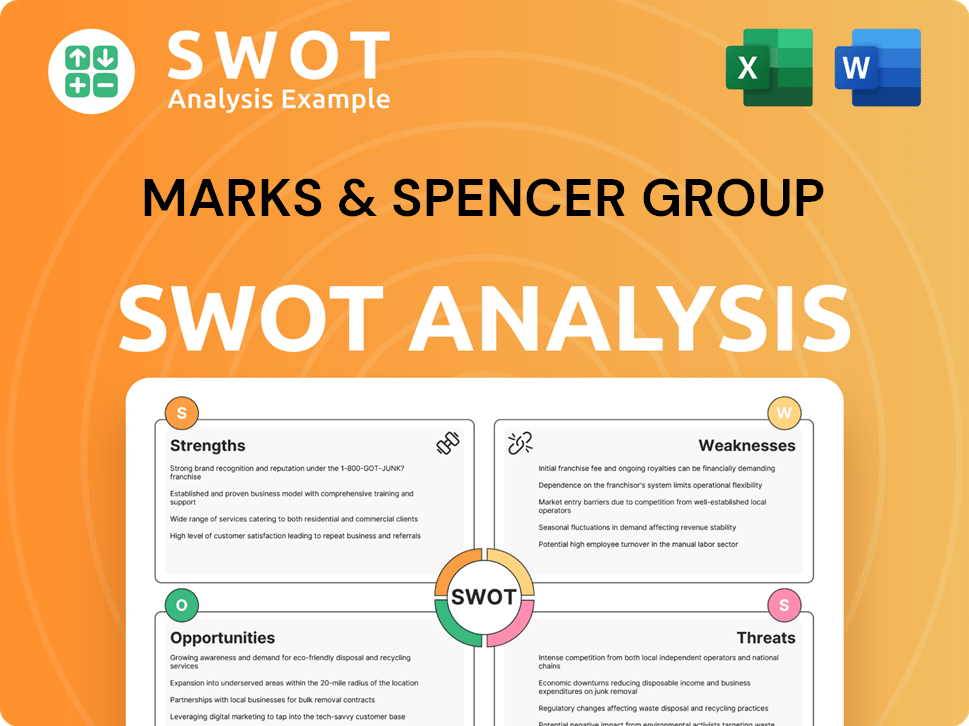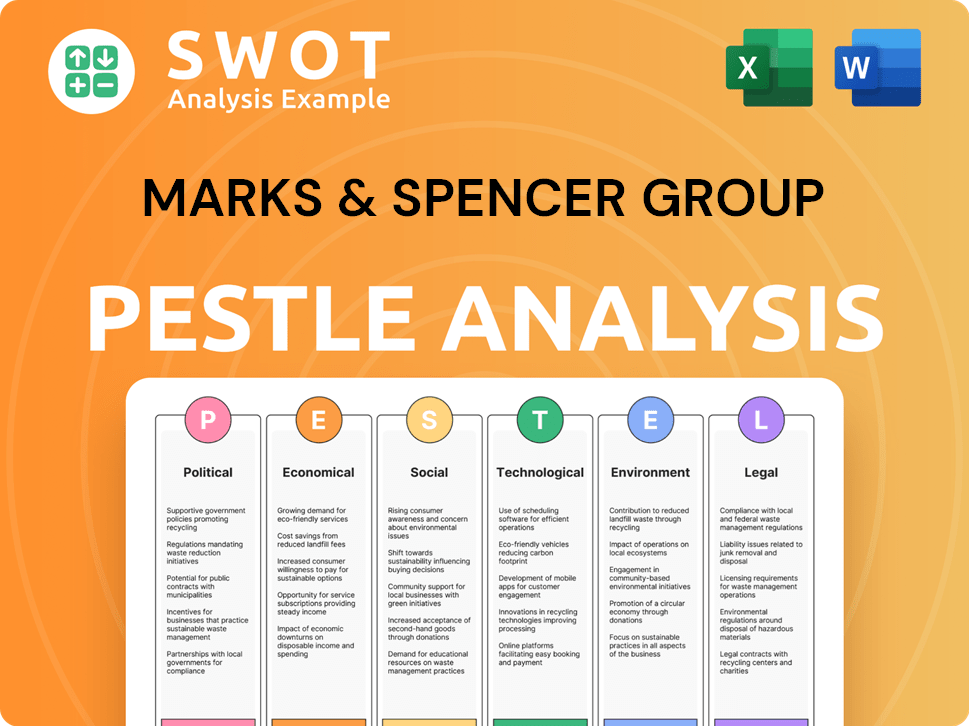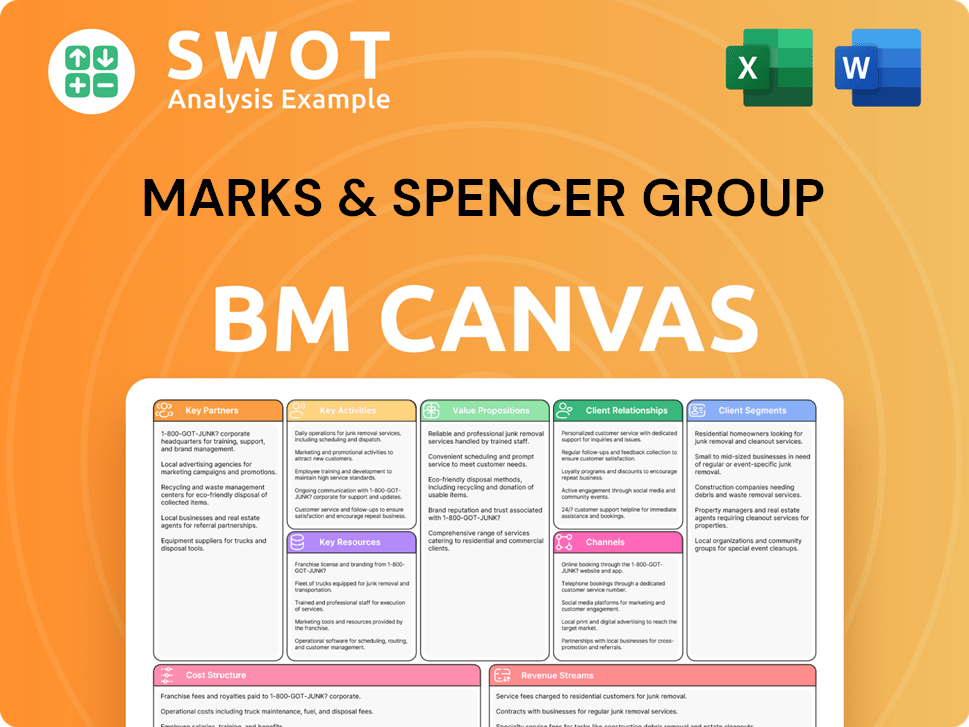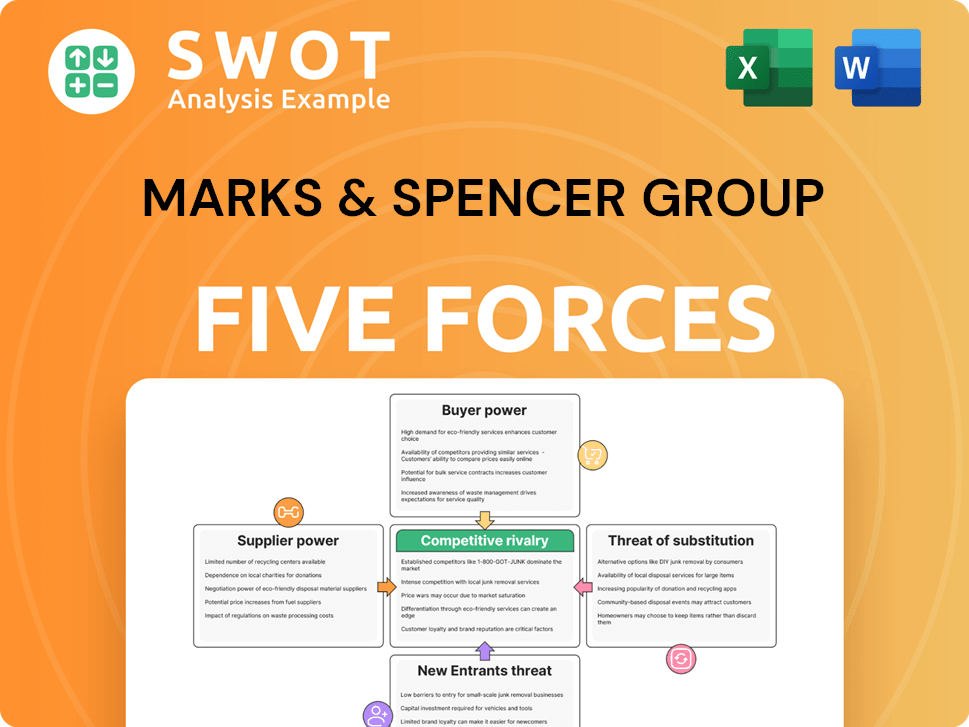Marks & Spencer Group Bundle
Decoding M&S: What Drives the Retail Giant?
Every successful business is built on a foundation of purpose. Understanding the Marks & Spencer Group SWOT Analysis is crucial for understanding the company's mission, vision, and core values. These elements are the compass guiding M&S's journey in the competitive retail landscape.

This article delves into the heart of Marks & Spencer, examining its mission statement explained, vision for the future, and core values examples. We'll explore how M&S defines its mission, the key strategic goals, and how these principles shape company culture, influence decision-making, and drive sustainable growth. Discover the impact of Marks & Spencer's values on employees and how their vision aligns with its products.
Key Takeaways
- M&S's mission, vision, and values are fundamental to its identity and strategic direction.
- Customer trust, quality, value, and service are central to M&S's guiding principles.
- M&S aims for international, multi-channel leadership within the retail sector.
- Alignment with core principles is crucial for M&S's future success.
- A clear corporate purpose is vital for long-term relevance in retail.
Mission: What is Marks & Spencer Group Mission Statement?
Marks & Spencer's mission is 'To be the most trusted retailer, in touch with our customers, and delivering quality, value, and service.'
The Marks & Spencer mission statement is a cornerstone of its identity, guiding its operations and interactions with both customers and stakeholders. This mission statement, while straightforward, encapsulates the essence of the M&S Group Strategy: to build and maintain a strong, trusted brand. The core of this mission revolves around three key pillars: quality, value, and service, all aimed at creating a distinct and positive customer experience. Understanding the nuances of this mission provides valuable insight into M&S's strategic direction and its approach to the competitive retail landscape.
The mission places significant emphasis on being "in touch with our customers." This highlights M&S's commitment to understanding and responding to customer needs and preferences. This customer-centricity is essential for building trust and loyalty, which are vital for long-term success in the retail sector.
The mission statement explicitly states the commitment to delivering "quality, value, and service." These are not merely aspirational goals but fundamental aspects of the M&S brand. Quality refers to the high standards of products offered, value emphasizes affordability, and service focuses on the overall customer experience.
M&S targets a broad customer base, appealing to those seeking reliable, high-quality products across clothing, home goods, and food. This broad appeal is a key part of M&S's strategy to maintain a large and diverse customer base. The company aims to cater to a wide range of demographics, from families to young professionals.
M&S offers a diverse range of products and services, primarily focusing on its own-brand lines. This includes clothing, home products, and food, with the M&S Food Hall being a particularly strong segment. The emphasis on own-brand products allows M&S to control quality and brand perception.
The market scope of M&S is both domestic (within the UK) and international. While the UK remains its primary market, M&S has a presence in various international locations through its stores and online platforms. This global reach helps diversify its revenue streams and mitigate risks.
The unique value proposition of M&S lies in the combination of trust, quality, value, and service. This combination aims to create a distinct customer experience that differentiates M&S from its competitors. This value proposition is what drives customer loyalty and repeat business.
The Marks & Spencer mission statement explained also reveals the company's commitment to adapting to evolving consumer preferences and market trends. While the core principles of quality, value, and service remain constant, M&S continuously seeks to innovate in product development, supply chain management, and customer service to maintain its relevance. For instance, M&S has been investing in its online platform and digital capabilities to enhance the shopping experience and cater to the growing demand for online retail. In the fiscal year 2024, M&S reported a significant increase in online sales, demonstrating the success of these initiatives. Furthermore, M&S's focus on sustainability and ethical sourcing aligns with its mission to be a trusted retailer, reflecting its commitment to responsible business practices. The company has set ambitious goals to reduce its environmental impact and promote sustainable practices throughout its operations. To further understand the financial aspects, the Revenue Streams & Business Model of Marks & Spencer Group provides detailed insights into how M&S generates revenue and operates its business.
Marks & Spencer Group SWOT Analysis
- Complete SWOT Breakdown
- Fully Customizable
- Editable in Excel & Word
- Professional Formatting
- Investor-Ready Format

Vision: What is Marks & Spencer Group Vision Statement?
Marks & Spencer's vision is 'to become a leading international, multi-channel retailer.'
The Mission, Vision & Core Values of Marks & Spencer Group reflect its aspirations for the future. This forward-looking statement encapsulates M&S's ambition to achieve a prominent position on the global stage, not just within the UK. The company's strategic goals are clearly defined by this vision.
The vision emphasizes international growth, signaling M&S's intent to expand its presence beyond its established UK market. This involves targeting new geographical regions and adapting its offerings to suit local consumer preferences. Recent data shows M&S has been focusing on strategic partnerships and franchise models to accelerate its international expansion, particularly in Asia and the Middle East.
The 'multi-channel' aspect of the vision highlights the importance of providing a seamless shopping experience across various platforms. This includes physical stores, online platforms, and mobile applications. M&S has invested heavily in its digital infrastructure, with online sales playing an increasingly significant role in its overall revenue, contributing to approximately 30% of total sales in the last financial year.
The vision aims for market leadership, indicating a desire to be recognized as a top performer in the retail industry. This involves not only increasing market share but also setting industry standards in terms of product quality, customer service, and sustainability. M&S's focus on premium products and ethical sourcing aligns with this ambition, attracting a customer base that values quality and responsibility.
To achieve its vision, M&S must continually adapt to changing consumer behaviors and embrace innovation. This includes staying ahead of trends in fashion, food, and technology. Recent initiatives, such as the introduction of new digital services and the expansion of its food offerings, demonstrate M&S's commitment to innovation.
M&S's vision is closely linked to its commitment to sustainability and ethical practices. The company aims to integrate these values into every aspect of its operations, from sourcing raw materials to reducing its environmental footprint. M&S's Plan A initiative, which focuses on sustainable sourcing and reducing waste, is a key component of its overall strategy.
The ultimate measure of success for M&S's vision is its financial performance. This includes revenue growth, profitability, and shareholder value. Recent financial reports indicate that M&S is making progress in these areas, with improvements in its operating margin and a focus on cost efficiency. The company's strategic goals are designed to drive sustainable financial growth.
The
Marks & Spencer Group PESTLE Analysis
- Covers All 6 PESTLE Categories
- No Research Needed – Save Hours of Work
- Built by Experts, Trusted by Consultants
- Instant Download, Ready to Use
- 100% Editable, Fully Customizable

Values: What is Marks & Spencer Group Core Values Statement?
While Marks & Spencer (M&S) may not explicitly publish a formal list of core values in recent statements, its actions and public image consistently reflect a commitment to certain principles. These implicit values are central to the M&S Group Strategy and shape the company's culture and brand identity.
Quality is a cornerstone of the Marks & Spencer brand, influencing everything from product sourcing to customer experience. This is evident in their 'Plan A' sustainability commitments, which guide product sourcing and ethical production, aiming for higher quality standards. This commitment to excellence is reflected in the company's focus on detail and its dedication to provide high-quality products and services, which is a key element in how M&S defines its mission.
Value for money is another core tenet, balancing quality with affordability to ensure customer satisfaction. M&S achieves this through strategic pricing, loyalty programs, and efficient supply chain management. This approach helps M&S maintain a competitive edge while upholding its commitment to quality, which is a key part of Marks & Spencer mission statement explained.
Excellent customer service is a priority across all channels, encompassing knowledgeable staff, efficient online ordering, and responsive customer support. M&S invests in employee training and technological advancements to improve the customer journey, ensuring a positive experience. This focus on service is crucial for achieving Marks & Spencer Goals and maintaining customer loyalty.
Building and maintaining customer trust is paramount for M&S, achieved through consistent quality, transparent communication, and ethical practices. This trust is reinforced through their handling of customer data, their commitment to sustainability, and their long-standing reputation. The company's approach to sustainability and core values contribute to this trust, as does its ethical sourcing practices, which are critical for the long-term success of the company.
These core values, though not always explicitly stated, profoundly influence the company's operations and its relationship with its customers. They differentiate M&S from competitors and contribute to its enduring brand identity. To understand the evolution of these values, consider reading a Brief History of Marks & Spencer Group. Next, we will explore how the Marks & Spencer Mission and Vision influence the company's strategic decisions.
How Mission & Vision Influence Marks & Spencer Group Business?
Marks & Spencer's (M&S) mission, vision, and core values are not just aspirational statements; they are the foundational pillars upon which the company builds its strategic decisions. These guiding principles shape every aspect of the business, from product development to market expansion, ensuring a cohesive and purpose-driven approach.
The Marks & Spencer mission to be the 'most trusted retailer' profoundly influences its strategic choices. This commitment to trust directly impacts decisions related to product sourcing, quality control, and customer service investments. The "Plan A" sustainability strategy, for instance, reinforces trust by ensuring responsible sourcing and production, aligning with the mission's emphasis on quality and ethical practices. The company’s focus on providing high-quality products and excellent customer service is a direct reflection of its mission to be the most trusted retailer.
- Product Sourcing: M&S prioritizes ethical and sustainable sourcing, reflected in its "Plan A" commitments. In 2023, 100% of M&S’s cotton was sustainably sourced.
- Quality Control: Rigorous testing and quality checks are integral to maintaining the brand's reputation for high-quality products.
- Customer Service: Investments in staff training and digital platforms aim to enhance the customer experience, fostering trust and loyalty.
- Financial Impact: M&S's commitment to its mission helps drive customer loyalty, which is reflected in its financial performance. In the latest financial year, M&S reported a significant increase in customer loyalty.
The Marks & Spencer vision of becoming a 'leading international, multi-channel retailer' drives strategic decisions regarding market expansion, online platform development, and logistics infrastructure. This vision necessitates continuous investment in digital capabilities to enhance the customer experience and expand its global reach. This vision is also about adapting to changing consumer behaviors and market dynamics, ensuring the company remains competitive and relevant in the retail landscape.
The multi-channel approach is a key strategic focus. Investment in its online platform and the development of a seamless customer experience across all channels are crucial. Partnerships, such as the one with Ocado for food delivery, are strategic moves aimed at enhancing their multi-channel reach and competitiveness. M&S has significantly increased its online sales, with digital sales accounting for a substantial portion of its total revenue.
The vision fuels international expansion efforts. M&S identifies key international markets for growth and invests in the necessary infrastructure to support its global presence. The company’s strategy includes expanding its presence in existing markets and exploring new opportunities. The international segment contributes a significant portion of the company's overall revenue, demonstrating the success of this vision-driven strategy.
The influence on day-to-day operations is seen in training programs focused on customer service and quality standards. Long-term planning involves identifying key international markets for expansion and investing in the necessary infrastructure. M&S focuses on employee development and training programs to ensure that its workforce is aligned with its mission, vision, and core values. This includes training on customer service, product knowledge, and sustainability practices.
Measurable success metrics for this alignment include growth in online sales, performance in international markets, and customer satisfaction scores. M&S closely monitors key performance indicators (KPIs) to measure the effectiveness of its mission and vision-driven strategies. These KPIs include customer satisfaction scores, online sales growth, international market performance, and the success of its sustainability initiatives. These metrics help the company assess progress and make necessary adjustments to its strategies.
The Marks & Spencer core values are embedded in its company culture and guide employee behavior and decision-making. These values support the mission and vision by providing a framework for ethical conduct, innovation, and customer focus. The core values are not just words; they are the principles that guide the company's actions and interactions. These values are reflected in its products, services, and interactions with stakeholders. For more information about the competitive landscape, you can read the Competitors Landscape of Marks & Spencer Group.
In conclusion, the Marks & Spencer mission, Marks & Spencer vision, and Marks & Spencer core values are inextricably linked, shaping the company's strategic direction and influencing its daily operations. Understanding this interplay is crucial for appreciating M&S's approach to business and its commitment to long-term success. The next chapter will explore the recent and planned improvements to these foundational elements.
Marks & Spencer Group Business Model Canvas
- Complete 9-Block Business Model Canvas
- Effortlessly Communicate Your Business Strategy
- Investor-Ready BMC Format
- 100% Editable and Customizable
- Clear and Structured Layout

What Are Mission & Vision Improvements?
While Marks & Spencer's current statements provide a foundation, strategic refinements can enhance their relevance and competitiveness in today's rapidly evolving retail landscape. These improvements would better position M&S to attract a new generation of consumers and solidify its position as a leader in the industry.
To reflect the changing retail environment, M&S could strengthen its vision to explicitly emphasize digital leadership and innovation. This could involve incorporating language that highlights the company's commitment to leveraging technology to enhance the customer experience and improve operational efficiency. For example, the vision could be updated to "To be the leading international, digitally-driven, multi-channel retailer..." This aligns with the fact that online sales currently represent a significant and growing portion of M&S's revenue, with digital sales accounting for 36.7% of Clothing & Home sales in 2023.
As sustainability and ethical consumption become increasingly critical to consumers, M&S could more explicitly highlight its leadership in responsible retail within its mission or core values. Building upon its existing Plan A commitments, this could involve framing sustainability as a core value, demonstrating a commitment to environmental stewardship, ethical sourcing, and social responsibility. This is particularly relevant as consumers, especially younger demographics, are increasingly making purchasing decisions based on a company's environmental and social impact. A recent study indicated that 73% of global consumers are willing to change their consumption habits to reduce their environmental impact.
To ensure the Marks & Spencer Mission statement remains relevant and actionable, consider updating it to be more concise and results-oriented. This could involve clarifying the company's primary focus, whether it's on providing high-quality products, exceptional customer service, or sustainable practices. A more focused mission statement can help guide decision-making and ensure all employees understand the Marks & Spencer Goals. For example, the mission could be updated to reflect the company's commitment to its core customer base, which is a key component of the overall M&S Group Strategy.
To ensure the Marks & Spencer Core Values are effectively communicated and lived throughout the organization, consider initiatives to reinforce M&S Company Culture. This could involve regular training programs, employee recognition initiatives, and incorporating the values into performance evaluations. Consistent communication and reinforcement of the values are crucial for ensuring they guide employee behavior and decision-making. For a deeper dive into the company's overall strategy, consider reading about the Growth Strategy of Marks & Spencer Group.
How Does Marks & Spencer Group Implement Corporate Strategy?
Implementing the Marks & Spencer mission, vision, and core values is crucial for translating strategic intent into tangible outcomes. This involves aligning business operations, employee behavior, and stakeholder communications to reflect the company's guiding principles.
A core element of implementing the Marks & Spencer vision is its investment in digital capabilities and a multi-channel retail strategy. This ensures that the company can meet the changing demands of consumers and remain competitive in the market.
- Significant investment in its online platform, including website and mobile app improvements.
- Enhancements to online ordering and delivery services to provide a seamless customer experience.
- Expansion of digital marketing efforts to reach a wider audience and drive online sales.
- Integration of online and offline experiences, such as click-and-collect services.
Leadership plays a pivotal role in reinforcing the Marks & Spencer mission and vision throughout the organization. Effective communication and consistent messaging are vital for aligning employees with the company's goals.
Training programs are essential for instilling the Marks & Spencer core values in employees and ensuring consistent service quality. This helps to build a strong company culture and enhance customer satisfaction.
Communicating the Marks & Spencer mission, vision, and values to stakeholders is crucial for building trust and transparency. This is done through corporate reports, investor presentations, and marketing campaigns.
The ethical sourcing practices under Plan A, reinforce the value of quality and trust. M&S is committed to sustainable practices, reflected in its products and operations, showcasing how Marks & Spencer's core values are put into action.
The alignment of these elements is crucial for achieving the Marks & Spencer Goals, which are focused on long-term value creation. For further insights into the ownership structure and financial performance, consider exploring the details at Owners & Shareholders of Marks & Spencer Group.
Marks & Spencer Group Porter's Five Forces Analysis
- Covers All 5 Competitive Forces in Detail
- Structured for Consultants, Students, and Founders
- 100% Editable in Microsoft Word & Excel
- Instant Digital Download – Use Immediately
- Compatible with Mac & PC – Fully Unlocked

Related Blogs
- What are Mission Vision & Core Values of Marks & Spencer Group Company?
- What is Competitive Landscape of Marks & Spencer Group Company?
- What is Growth Strategy and Future Prospects of Marks & Spencer Group Company?
- How Does Marks & Spencer Group Company Work?
- What is Sales and Marketing Strategy of Marks & Spencer Group Company?
- Who Owns Marks & Spencer Group Company?
- What is Customer Demographics and Target Market of Marks & Spencer Group Company?
Disclaimer
All information, articles, and product details provided on this website are for general informational and educational purposes only. We do not claim any ownership over, nor do we intend to infringe upon, any trademarks, copyrights, logos, brand names, or other intellectual property mentioned or depicted on this site. Such intellectual property remains the property of its respective owners, and any references here are made solely for identification or informational purposes, without implying any affiliation, endorsement, or partnership.
We make no representations or warranties, express or implied, regarding the accuracy, completeness, or suitability of any content or products presented. Nothing on this website should be construed as legal, tax, investment, financial, medical, or other professional advice. In addition, no part of this site—including articles or product references—constitutes a solicitation, recommendation, endorsement, advertisement, or offer to buy or sell any securities, franchises, or other financial instruments, particularly in jurisdictions where such activity would be unlawful.
All content is of a general nature and may not address the specific circumstances of any individual or entity. It is not a substitute for professional advice or services. Any actions you take based on the information provided here are strictly at your own risk. You accept full responsibility for any decisions or outcomes arising from your use of this website and agree to release us from any liability in connection with your use of, or reliance upon, the content or products found herein.